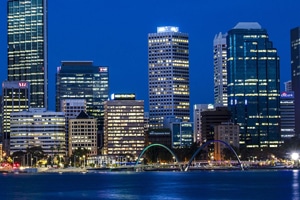Please fill out the details below to receive information on Blue Wealth Events
"*" indicates required fields

Perth’s economy, arguably Australia’s largest benefactor from the most recent resources boom, has struggled to maintain the rate of growth set between 2003 and 2011. The property market has performed similarly, feeling the effects of a rising unemployment rate and loss of consumer confidence. As at September 2017, the Australian Bureau of Statistics (ABS) indicated that Perth’s median house price was $500,000, a 10% fall from three years prior.
In past years Western Australia boasted one of the strongest economies in the country, but in 2017 it was less than satisfactory as it performed worse than any other state in the country, declining 2.7%. This is a significant fall on the ten-year average of 3.9% growth.
Population growth figures remain well below peak and average levels for Western Australia. In 2017 20,000 people were added to the population as opposed to the 85,000 during the mining boom and the historic annual average growth rate of 45,000 for Western Australia.
The dramatic rise in Chinese demand for resources was key to the uplift in demand and growth in Perth’s property market. In 2016, the price of iron ore doubled to $US80 per tonne, injecting an estimated $2 billion into Western Australia’s state revenue and restoring some confidence in the property market. The growth in iron ore prices has brought some positivity back to the mining economy.
In the post-mining boom period, the loss of jobs and subdued growth in median incomes led to a reduction in demand for property in terms of sales and rentals. The property market’s correction from the dizzy heights of the mining boom is still evident in all facets of the market. The twenty-four months to June 2016 saw declines in both median attached and detached dwellings prices, 12% and 5% respectively. Similarly, the rental market has softened, with rental yields for apartments declining from 6% to 4.3% according to SQM Research. In 2017 vacancy rates rose to 5%. As at January 2018 the city’s vacancy rate currently sat at 4.5%, a steady reduction from the 5% vacancy recorded in early 2017.
In some ways, 2017 can be labelled as a year of market recalibration. The stability that residents and investors alike have yearned for has now entered the market; home values and rental yields are no longer falling and have plateaued. This is a sign of Perth reaching the bottom of the market.
Outlook for 2018
More positive media exposure and the state government’s aggressive approach to infrastructure investment are driving a sentimental shift in Perth while also creating thousands of jobs. The following projects under construction and recently completed are restoring confidence in the market while also challenging the perception of Perth’s reliance on the resources sector:
Perth City Link project ($5.3 billion)
Elizabeth Quay project ($2.6 billion)
East Perth Riverside ($2.1 billion)
Fiona Stanley Hospital ($2 billion)
International airport-city link ($2 billion)
New Perth Stadium ($1.2 billion)
Perth Children’s Hospital ($1.2 billion)
Gateway Transport update ($1 billion)
Perth Arena ($548 million)
New Perth Museum ($428 million)
After appearing to reach the bottom of the market in 2017, Perth is likely to begin a slow recovery. The outlook for Perth from hereon is looking more positive.
